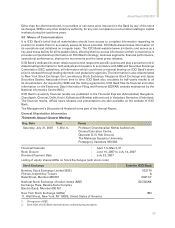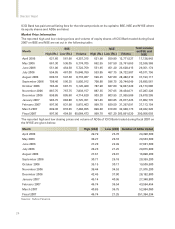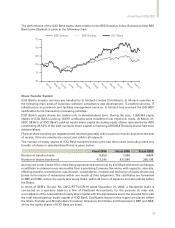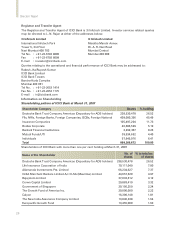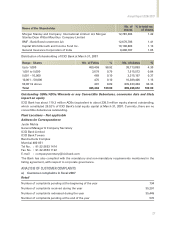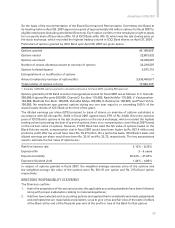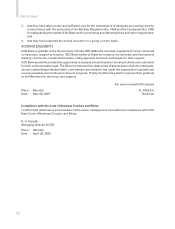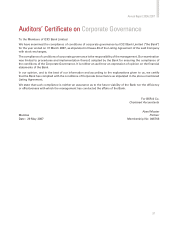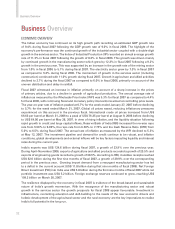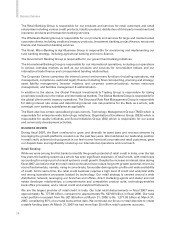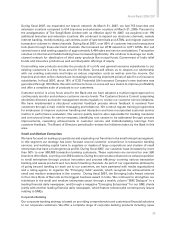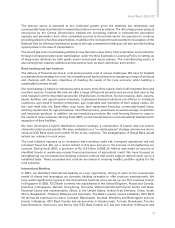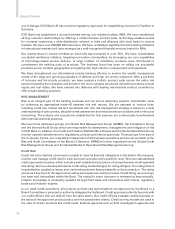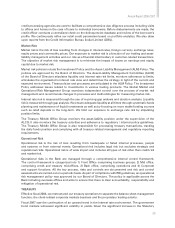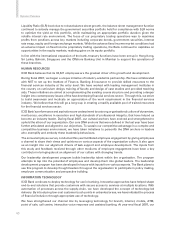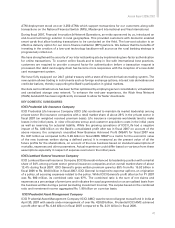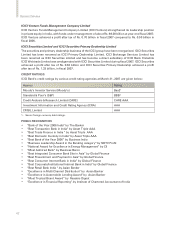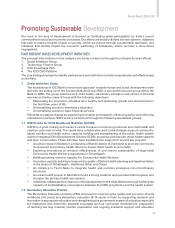ICICI Bank 2007 Annual Report Download - page 35
Download and view the complete annual report
Please find page 35 of the 2007 ICICI Bank annual report below. You can navigate through the pages in the report by either clicking on the pages listed below, or by using the keyword search tool below to find specific information within the annual report.
33
Annual Report 2006-2007
FINANCIAL SECTOR OVERVIEW
The financial sector mirrored the developments in the Indian economy. Credit growth was robust, given
the increase in economic activity. Non-food credit increased by 28.0% in fiscal 2007 compared to 30.8%
in fiscal 2006. Based on data published by RBI, during April-December 2006, industry accounted for
38.5% of non-food credit, retail credit for 26.4%, agriculture and allied activities for 12.2%, trade for
6.1%, real estate for 2.4% and other sectors for the balance 14.4%. The credit-deposit ratio increased
from about 70.0% in April 2006 to about 74.0% in March 2007. The incremental credit-deposit ratio was
about 86.0% for fiscal 2007 compared to about 102.0% for fiscal 2006, on account of robust growth in
deposits during fiscal 2007. Deposits of the banking system grew by Rs. 5,130.05 billion, or 24.2%, in
fiscal 2007 compared to 17.4% in fiscal 2006. In response to the increase in the cash reserve ratio and
the reverse repo rate and the liquidity conditions, banks have increased their lending and deposit rates.
The average yield on 10-year Government securities increased from 7.1% in fiscal 2006 to 7.8% in fiscal
2007.
Growth in both the life and non-life insurance markets was significant. First year retail premium
underwritten in the life insurance sector recorded a growth of 91.9% (on weighted received premium
basis) to reach Rs. 402.77 billion in fiscal 2007 with the private sector’s retail market share (on weighted
received premium basis) increasing from 34.2% in fiscal 2006 to 35.5% in fiscal 2007. Gross premium in
the non-life insurance sector (excluding Export Credit Guarantee Corporation of India Limited) grew by
22.4% to Rs. 250.02 billion in fiscal 2007 with the private sector’s market share increasing from 26.6% in
fiscal 2006 to 34.9% in fiscal 2007. Total assets under management of mutual funds grew by 40.8% from
Rs. 2,318.62 billion at March 31, 2006 to Rs. 3,263.88 billion at March 31, 2007.
The banking sector witnessed several important regulatory developments. In April 2007, RBI issued final
guidelines for the implementation of a revised Basel II capital adequacy framework that would be effective
year-end fiscal 2008 for banks like us. The guidelines include an increase in the minimum Tier-I CAR from
4.5% to 6.0% and introduction of capital for operational risk. The guidelines prescribe a 75.0% weight
for retail credit exposure and rating based differential risk weights for other credit exposures, including
on undrawn commitments. During the fiscal year, RBI increased the general provisioning requirement
on standard advances in specific sectors to 1.0% from 0.4%. In January 2007, RBI further increased
the general provisioning requirement for real estate sector loans (excluding residential housing loans),
credit card receivables, loans and advances qualifying as capital market exposure, personal loans and
exposures to non-deposit taking systemically important non-banking financial companies to 2.0%. In
April 2007, RBI issued revised guidelines on lending to the priority sector. The guidelines are effective
fiscal 2008 and link priority sector lending targets to adjusted net bank credit. In April 2007, RBI issued
draft guidelines aimed at permitting banks and primary dealers to begin transactions in credit default
swaps. RBI also issued modified consolidated supervision norms limiting a bank’s consolidated capital
market exposure limit at 40.0% of its consolidated net worth and restricting direct exposure to 20.0% of
the consolidated net worth.
The Indian financial sector is rapidly moving towards international benchmarks, with increasing efficiency,
transparency and dynamism. Given the robust growth prospects in India, the financial sector has a
crucial role to play in the development of the economy. Broad-based reforms have made the banking
sector competitive and have positioned it well to support sustained economic growth.
ORGANISATION STRUCTURE
Our organisation structure is designed to be flexible and customer-focused, while seeking to ensure
effective control and supervision and consistency in standards across the organisation and align all
areas of operations to overall organisational objectives. The organisation structure is divided into six
principal groups – Retail Banking, Wholesale Banking, International Banking, Rural, Micro-Banking and
Agri-Business, Government Banking and Corporate Centre.


